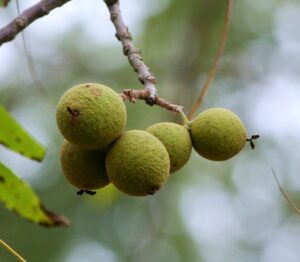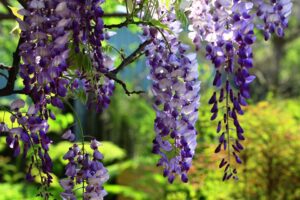Explore the Best Black Walnut Companion Plants that thrive with this majestic tree without succumbing to juglone toxicity.
Growing plants near black walnut trees can be a challenge due to the allelopathic effects of juglone. However, by selecting the right black walnut companion plants, you can create a thriving garden that is not affected by this toxic chemical. In this guide, we’ll explore some of the Best Black Walnut Companion Plants that can coexist with them.
Read the Martha Washington Geranium Care Guide
Black Walnut Tree

The black walnut tree (Juglans nigra) is a popular hardwood tree found in many residential landscapes. While valued for its shade and delicious nuts, it’s important to note that certain plants may not thrive when grown near the tree due to its toxicity.
The allelopathic effects of black walnut toxicity can be fatal to some plants growing in close proximity to the tree. Certain plants are classified as either sensitive or tolerant to the effects of juglone, which comes from the roots of the black walnut tree. When exposed to juglone, sensitive plants may exhibit yellowing, leaf loss, wilting, and eventual death.
While other trees like the pecan and bitternut hickory also contain juglone, they do not produce as much of the chemical as the black walnut. This makes them less harmful to other plants, and only the black walnut is known to cause black walnut toxicity in neighboring plants.
Also Read: Night Owl Snake Plant Care
Black Walnut Companion Plants
To avoid black walnut toxicity, planting only compatible plants is a simple and effective approach. These compatible plants are species known to thrive under black walnut trees without experiencing any negative effects from juglone.
Read Resurrection Plant Growing Guide
Black Walnut Companion Fruit Trees

1. Quince (Cydonia oblongata)
2. Cherry (Prunus)
3. Plum (Prunus domestica)
4. Peach (Prunus persica)
5. Nectarine (Prunus persica nucipersica )
Black Walnut Companion Herbaceous Flowers

6. Trillium (Trillium spp)
7. Christmas Rose (Helleborus spp)
8. Globeflower (Trollius spp)
9. Pansy and Violet (Viola spp)
10. Meadowrue (Thalictrum spp)
11. Cranesbill Geranium (Geranium sanguineum)
12. Stonecrop (Sedum acre, Sedum spectabile)
13. Gentian (Gentian spp)
14. Sweet Woodruff (Galium odoratum)
15. Lamb’s Ear (Stachys byzantia)
16. Common Daylily (Hemerocallis spp)
17. Dog’s Tooth Violet (Erythronium spp)
18. Snowdrop (Galanthus nivalis)
19. Tulips (Tulipa spp)
20.Siberian or Blue Squill (Scilla siberica)
21. Epimedium (Epimedium spp)
22. Lungwort (Pulmonaria spp)
23. Bloodroot (Sanguinaria canadensis)
24. Orange Hawkweed (Hieracium aurantiacum)
25. Zinnia (Zinnia spp)
26. Winter Aconite (Eranthis hyemalis)
27. Solomon’s Seal (Polygonatum commutatum)
28. Crested Wood Fern (Dryopteris cristata)
29. Primrose (Primula spp)
30. Phlox (Phlox paniculata)
31. Dutchman’s Breeches (Dicentra cucullaria)
32. Jacob’s Ladder (Polemonium reptans)
33. Leopard’s Bane (Doronicum spp)
34. Spiderwort (Tradescantia virginiana)
35. Mayapple (Podophyllum peltatum)
36. Daffodil (Narcissus spp)
37. Chrsyanthemum (Chrysanthemum spp)
38. Bleeding Heart (Dicentra spp)
39. Christmas Fern (Polystichum acrostichoides)
40. Primrose and Sundrops (Oenothera spp)
41. Spring Beauty (Claytonia virginica)
42. Cinnamon Fern (Osmundastrum cinnamomeum)
43. Crocus (Crocus spp)
44. Purple Coneflower (Echinacea purpurea)
45. Grape Hyacinth (Muscari botryoides)
46. Glory of the Snow (Chionodoxa lucilae)
47. Pot Marigold (Calendula officinalis)
48. Bee Balm (Monarda spp)
49. Bellflower (Campanula latifolia)
50. Jerusalem Artichoke (Helianthus tuberosus)
51. Lobelia (Lobelia spp)
52. Fibrous and Tuberous Begonia (Begonia)
53. Liriope or Lilyturf (Lirope spp)
54. Jack-in-the-Pulpit (Arisaema triphyllum)
55. Aster (Aster spp)
56. European Wild Ginger (Asarum europaeum)
57. Yarrow (Achillea spp)
58. Hosta (Hosta spp)
59. Bugleweed (Ajuga reptans)
60. St. John’s Wort (Hypericum spp)
61. Anemone (Anemone spp)
62. Spanish Bluebell (Hyacinthoides hispanicus)
63. Hollyhock (Alcea rosea)
64. Morning Glory (Ipomoea spp)
65. Shasta Daisy (Leucanthemum x superbum)
66. Astilbe (Astilbe spp)
67. Virginia Bluebell (Mertensia virginica)
68. Coral Bells (Heuchera spp)
69. Sunflower (Helianthus)
70. Iris (Iris spp)
Black Walnut Companion Vegetables

71. Corn
72. Squash and Melons
73. Parsnip
74. Carrot
75. Beets
76. Onion
77. Beans
Black Walnut Companion Vines

78. Virginia Creeper (Parthenocissus quinquefolia)
79. Clematis (Clematis spp)
80. Wisteria (Wisteria spp)
81. Wild Grape (Vitis)
Black Walnut Companion Trees

82. Eastern Red Cedar (Juniperus virginiana)
83. Ohio Buckeye (Aesculus glabra)
84. Goldenrain Tree (Koelreuteria paniculata)
85. Sweetgum (Liquidambar styraciflua)
86. Virginia Pine (Pinus virginiana)
87. Catalpa (Catalpa bignoniodes)
88. Sycamore (Platanus occidentalis)
89. Pawpaw (Asimina triloba)
90. Yellow Poplar (Liriodendron tulipifera)
91. Serviceberry, Shadblow (Amelanchier)
92. River Birch (Betula nigra)
93. Black Gum (Nyssa sylvatica)
94. Hickory (Carya spp)
95. Eastern Redbud (Cercis canadensis)
96. Black Cherry (Prunus serotina)
97. Fringetree (Chionanthus spp.)
98. Flowering Dogwood (Cornus florida)
99. Persimmon (Diospyros virginiana)
100. Oak species (Quercus spp)
101. Dogwood (Cornus alternifolia)
102. Black Locust (Robinia pseudoacacia)
103. Staghorn Sumac (Rhus typhina)
104. American Beech (Fagus grandifolia)
105. Arborvitae (Thuja occidentalis)
106. White Ash (Fraxinus americana)
107. Hawthorne (Crataegus spp)
108. Canada Hemlock (Tsuga Canadensis)
109. Honeylocust (Gleditsia triacanthos)
110. Blackhaw Viburnum (Viburnum prunifolium)
111. American Elm (Ulmus americana)
112. Carolina Silverbell (Halesia caroliniana)
113. Sassafras (Sassafras albidum)
114. Most maples except silver maple (Acer spp)
Black Walnut Companion Shrubs

115. Snowball Hydrangea (Hydrangea arborescens)
116. St. Johnswort (Hypericum prolificum)
117. Spicebush (Lindera benzoin)
118. Mock orange (Philadelphus spp)
119. Barberry (Berberis spp)
120. Hazelnut (Corylus americana)
121. Witchhazel (Hamamelis virginiana)
122. Rose of Sharon (Hibiscus syriacus)
123. American Holly (Ilex opaca)
124. Juniper (Juniperus spp)
125. Smooth Sumac (Rhus glabra)
126. Black Raspberry (Rubus occidentalis)
127. Exbury Hybrid Azalea “Gibraltar” & “Balzac”
Sumac (Rhus copallina)
128. Currant (Ribes spp)
129. Daphne (Daphne spp)
130. Black Raspberry (Rubus occidentalis)
131. Koreanspice Viburnum (Viburnum carlesii)
132. Elderberry (Sambucus Canadensis)
133. Maple-leaved Viburnum (Viburnum acerifolia)
134. Forsythia (Forsythia spp)
135. Pinxterbloom Azalea (Rhododendron periclymenoides)
136. Red Oak ( Quercus rubra)
137. Purple Leaf Sandcherry (Prunus cistena)



